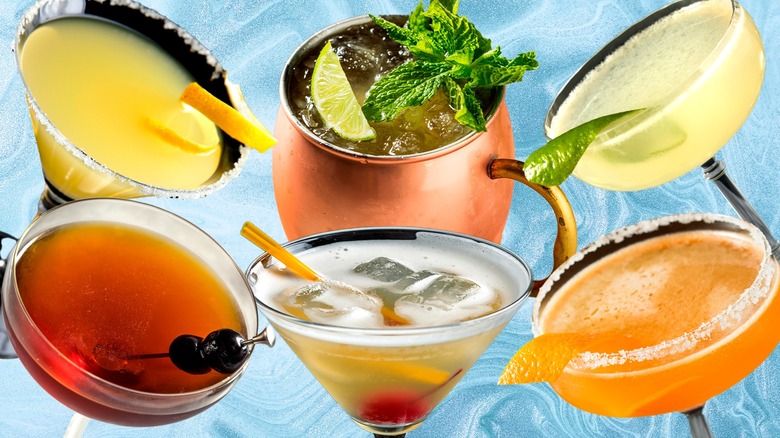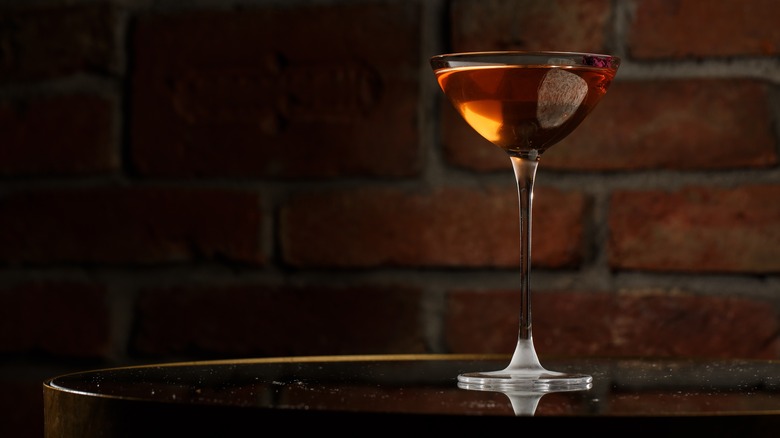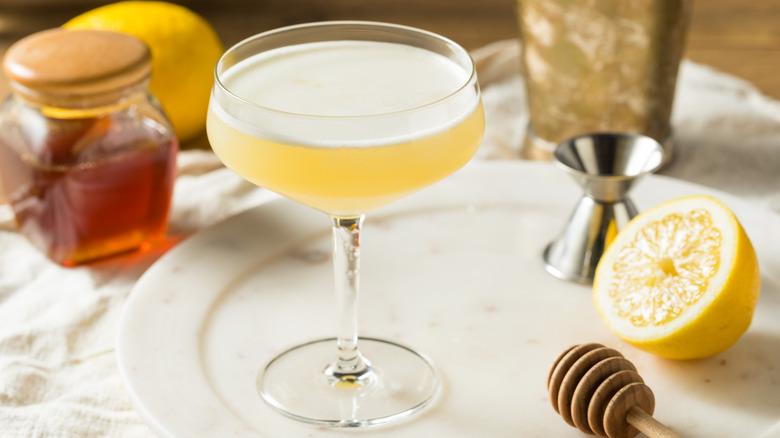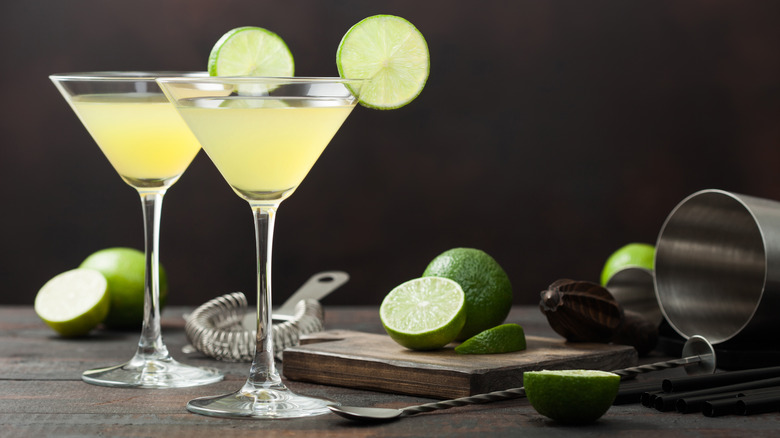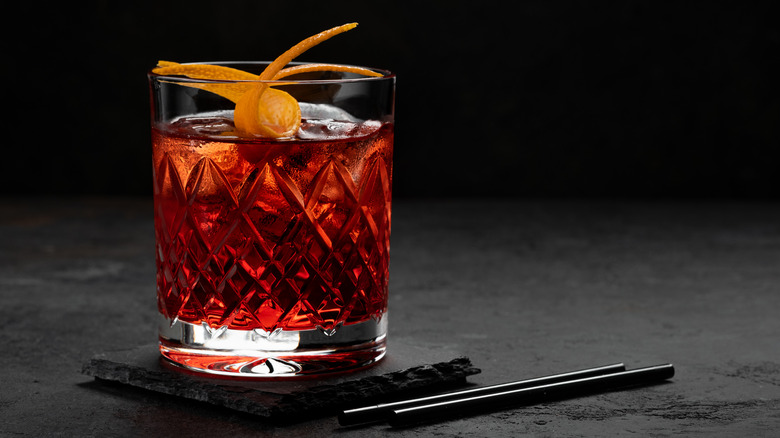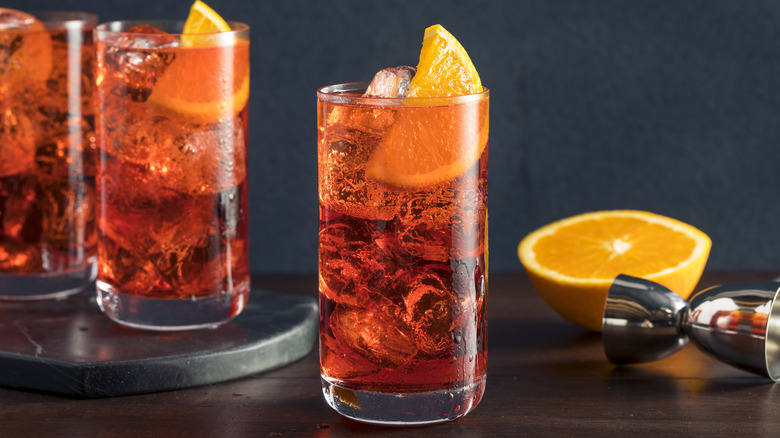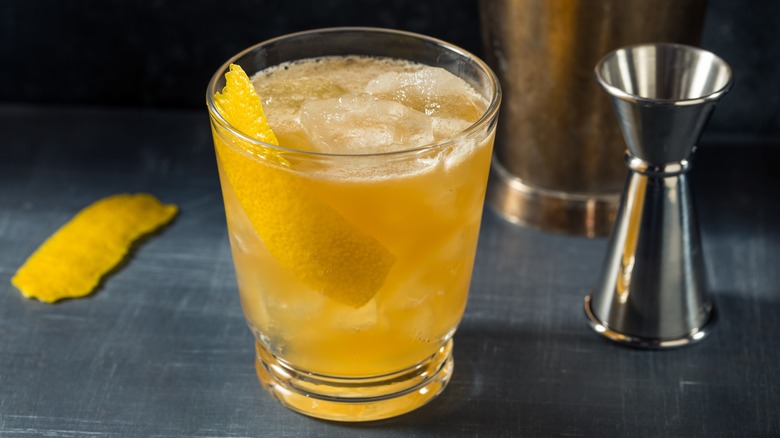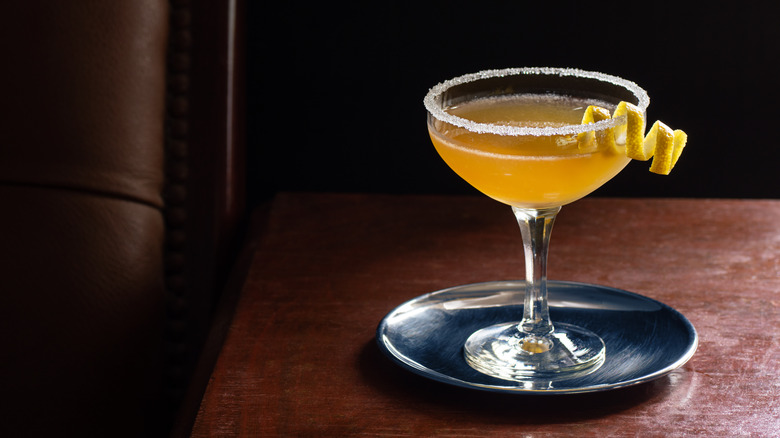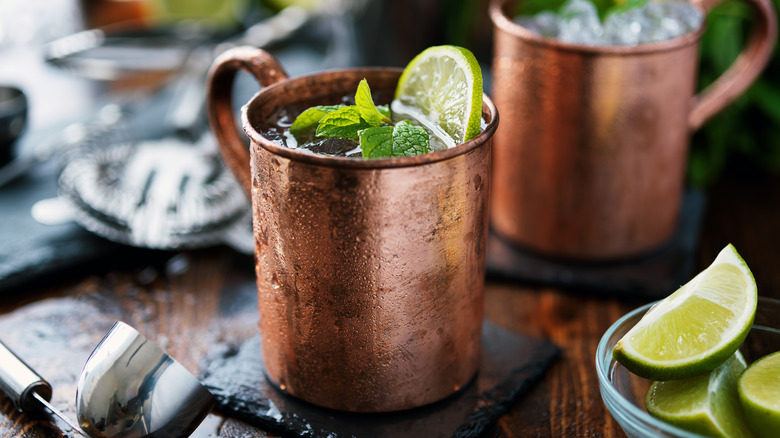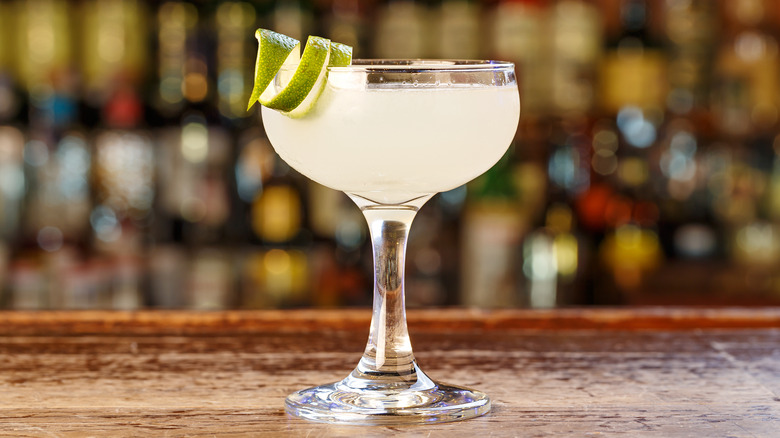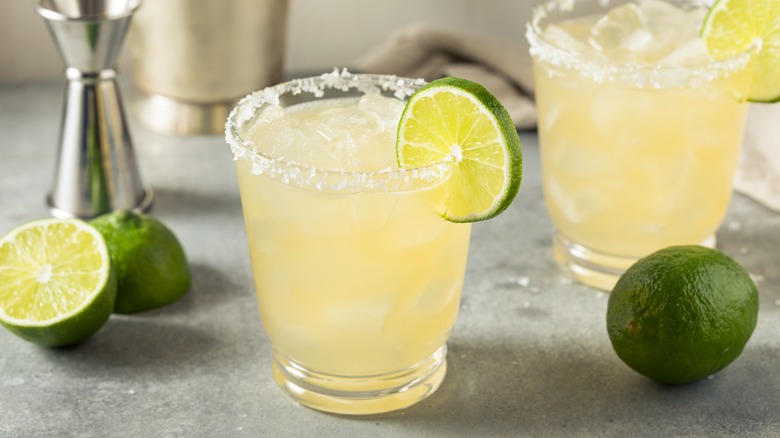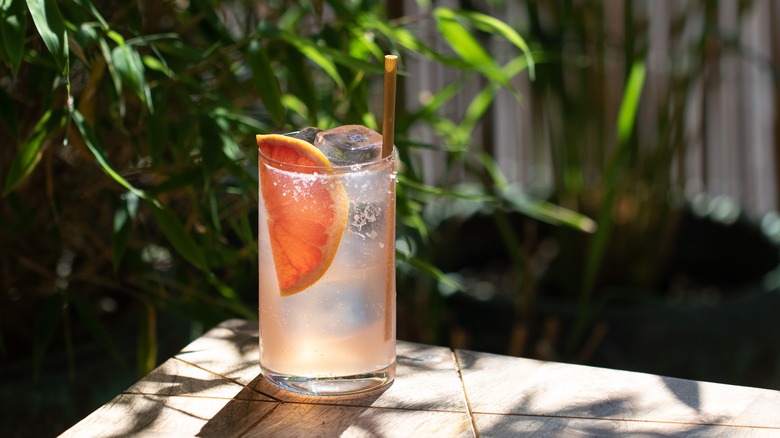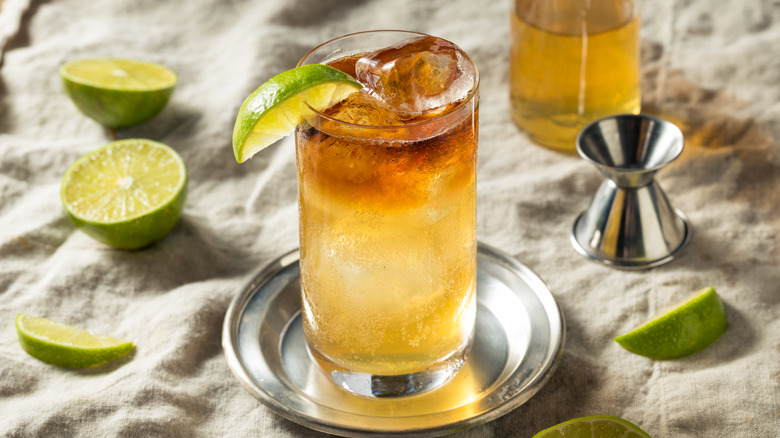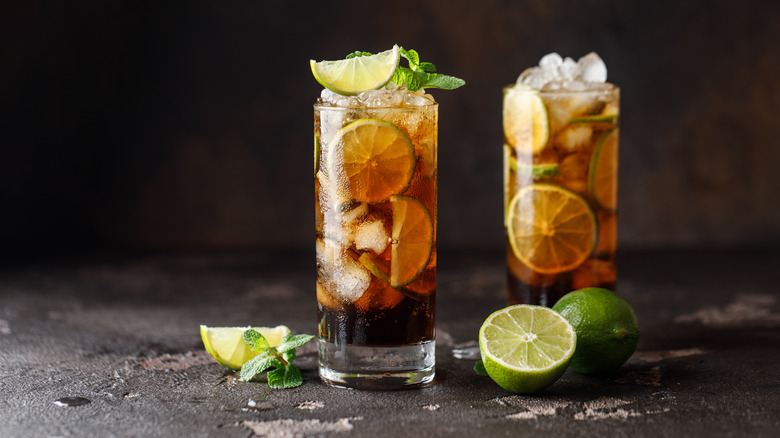The 13 Best Cocktails That Are Only 3 Ingredients
Mixing drinks at home should never have to be expensive. Although stocking your home bar with different liqueurs and spirits and using them to mix new drinks is always encouraged, you should want to make every bottle on your bar cart last as long as possible and get the most out of each purchase. Plus, there are plenty of delicious, easy-to-make cocktails that mostly consist of ingredients like citrus, syrups, or non-alcoholic mixers.
While crafting very complex drinks with many carefully measured ingredients can be very enjoyable, sometimes not having to think too much about the cocktail you are mixing for yourself is a more relaxing way to go. While there are many delicious two-ingredient cocktails like the gin and tonic or the rusty nail, there are even more great cocktails that only call for only one more element. Here are some of the best three-ingredients cocktails that will help put your entire home bar to good use.
Manhattan
The classic Manhattan is undoubtedly one of the most iconic cocktails in existence. This timeless classic dates all the way back to the mid-1800s and it is just as popular today as it has ever been. While the exact invention of the Manhattan remains unknown, there are a variety of theories behind its origin.
One belongs to Dr. Iain Marshall, who is said to have invented the cocktail during a party thrown by Lady Randolph Churchill (Winston Churchill's mother), but this has been debunked. Another theory states that the drink was simply created by a bartender at Hoffman House in New York City around the same time, but there's no confirmation of that, either.
Even the earliest published recipes for the Manhattan are different than how the cocktail is made today, many including gum syrup, which is a sweetener, in addition to the whiskey, vermouth, and bitters. Regardless, if you order a Manhattan today, you can expect a stirred concoction consisting of two ounces of whisky, traditionally rye, one ounce of sweet vermouth, and a few dashes of Angostura bitters.
The mixture is strained and served up, adorned with a maraschino cherry, and you have yourself one of the quintessential cocktails of the mixology craft. There have been many riffs on the Manhattan since its invention, but the classic three-ingredient combination is really the only one you'll ever need.
Bee's Knees
The creation of the Bee's Knees is unclear, but what is known, especially given the name of the drink, is that it is a Prohibition-era cocktail. This drink came about in part because bathtub gin was so prevalent at the time. These makeshift spirits were harsh on the palate, and adding something as sweet and rich as honey made it more palatable. The addition of lemon juice eventually made the combination a more cohesive and balanced drink, which has been sustained as a classic cocktail to this day.
Although a traditional Bee's Knees call for regular honey, it is actually more practical to use honey syrup, which is simply made by mixing honey and water. It's a more mixable solution that will not harden once introduced to cold ice when shaking. Honey not only balances the lemon juice in this cocktail, but it also contributes floral flavor notes that wonderfully complement the botanicals of the gin. Plus, different gins make for different takes on the Bee's Knees, another favorable characteristic of most three-ingredient cocktails.
One particular gin is Bar Hill Gin, which is actually made with raw honey for a very distinct flavor profile that's perfect for this cocktail. In fact, the brand even sponsors an annual Bee's Knees Week, which inspires many renditions of the cocktail as well as raises awareness and funds for revitalizing bee habitats in the northeast U.S.
Gimlet
The gimlet is another classic gin drink, this one predating Prohibition back to the 19th century. The name for the cocktail is a tribute to Sir Thomas Desmond Gimlette, a Royal Navy doctor who advised sailors suffering from scurvy to drink a mixture of lime juice and gin to boost their vitamin C intake. It was really only the lime juice that was needed to help with the deficiency, but the abundance of gin available to British officers at the time led to an inevitable mixture of the two.
Eventually, the quite abrasive nature of only dry gin and lime juice was made more palatable with the creation of a sweetened lime cordial called Rose's. The effectiveness of this cordial and gin combination to help keep sailors healthy led to lime juice being a required daily ration on every British naval ship.
Today, the gimlet is more recognized as a combination of gin, lime juice, and simple syrup that is shaken together and served up. This drink is a bright, tart, and fresh concoction that is a breeze to make and a classic for a reason. The gimlet's simplicity is what has kept it popular for over a century and a half. If you are a gin drinker, the gimlet is a delicious way to enjoy the spirit.
Negroni
The only thing more simple than a three-ingredient cocktail is one that is also an equal parts cocktail. The Negroni is one of the world's most iconic drinks, dating back over a century to its creation in 1919. The drink was invented in Florence when Count Camillo Negroni asked a bartender to strengthen his Americano. The bartender obliged by swapping out the club soda for London dry gin, and the rest is history. Since then, there have been countless riffs and variations on the Negroni featuring different liquors, vermouths, and other spirits, but the original really can't be beaten.
An ounce of gin, an ounce of sweet vermouth, and an ounce of Campari are all that is needed to mix up this cocktail, making it one of the easiest-to-make three-ingredient drinks on the list. Campari is an Italian aperitivo that is intensely bitter with a very bold profile. It is complemented greatly by and is a natural companion of the rich sweet vermouth, and the gin sharpens everything up with extra booze and botanicals.
Negronis (and Campari, for that matter) are definitely an acquired taste, so be sure to give this cocktail another fair shot if you find it too intense the first time. Once you do, it may become your go-to drink for the rest of your life.
Americano
The Americano is the precursor to the Negroni, which was invented with only a single ingredient substitution. The Americano is a highball made by mixing together equal parts Campari and sweet vermouth and topping it with soda water. This bright, effervescent, low-ABV cocktail is the perfect aperitif to kickstart an evening and one that is both simple and inexpensive to make.
Just as the Americano predates the Negroni, the Americano itself is predated by another cocktail. Sweet vermouth and Campari make for a wonderful combination since the flavors naturally enhance one another. Originally, this combo was known simply as a "Milano-Torino," representative of the cities in which the two ingredients were invented. During the turn of the century, American tourists would frequently request that their Milano-Torinos be topped with soda water. The revision gradually caught on with native Italians, who named their new favorite drink after the visitors who inspired it. The Americano has been a staple cocktail in Italy and beyond since, and is even the very first drink James Bond orders in Ian Fleming's "Casino Royale."
Gold Rush
There may be no cocktail that is more impactful on the modern mixology boom than the Gold Rush. Unlike many modern classic cocktails, this cocktail's invention is actually credited to a customer, not a bartender. In 1999, a man named T.J. Siegal entered the legendary Milk and Honey bar in New York City to pay his friend, bartender Sasha Petraske, a visit.
Petraske told Siegal about a honey syrup he had just made for a new drink, and Siegal asked for his regular whiskey sour to be made with the syrup instead of the usual simple syrup. The honey syrup, lemon juice, and bourbon combination eventually became one of the biggest hits of the Milk and Honey bar program and one of the fundamental cocktails of the current cocktail renaissance.
Traditionally, the whiskey sour is at least a four-ingredient drink that includes egg white and the optional addition of Angostura bitters. The Gold Rush omits the egg white and bitters altogether and calls for a honey substitution that makes for a cocktail that is familiar, yet entirely new and unique.
The Gold Rush is the perfect example of how one small tweak can completely reinvent a drink as a completely new thing. The barrel notes of the bourbon work wonders with the richness of the honey, and the lemon juice keeps everything vibrant and light. You probably have all of the required ingredients at home already, so do not hesitate to try this instant classic.
Sidecar
The sidecar is another classic three-ingredient cocktail with a murky origin story. In his 1948 book "Fine Art of Mixing Drink," David A. Embury credits the drink's invention to legendary bartender Harry MacElhone, author of "Harry's ABC of Mixing Cocktails" and inventor of Negroni riffs such as the Boulevardier and Old Pal.
According to Embury, MacElhone created the sidecar at his bar in Paris sometime in the 1920s. The name of the drink is supposedly a reference to a motorcycle sidecar, the means of transportation for MacElhone to his bar every day. While this is unconfirmed, what is certain is the sidecar's simplicity and longevity as a cocktail.
The sidecar is actually part of the daisy family of cocktails, which consist of drinks made with a base spirit, citrus, and a sweet liqueur. In this case, the framework is executed with cognac, lemon juice, and triple-sec. Cognac is not a widely utilized spirit in terms of mixology, but the sidecar puts the brandy to great use in this drink. Its richness is cut slightly by the lemon juice and the triple-sec helps to round everything out. Although cognac is already a sweeter spirit than most, the triple-sec has just enough of a bite to keep this drink in check.
Moscow Mule
This next cocktail has become one of the most prevalent drinks in existence and one that is synonymous with its very own serving vessel, the copper mug. The origin of the Moscow Mule is perhaps the most coincidental and fortuitous of any cocktail ever.
The story goes that in 1941, Sophia Beresinski, a Russian immigrant, found herself in a Los Angeles bar trying to figure out how to sell her inventory of copper mugs from her father's factory. Luckily, two other patrons of the bar included a man with a surplus of ginger beer and the new owner, at the time, of Smirnoff Vodka. Given vodka's lack of popularity in the U.S. in that era, business was slow. So, in order to remedy the problems of all three business people, a cocktail was constructed that put each of their products to use.
The result was eventually a combination of vodka, lime juice, and ginger beer served in a copper mug, otherwise known as the Moscow Mule. Today, the mule comes in many different versions, given that a simple spirit substitution instantaneously reinvents the cocktail to fit anyone's personal taste. Copper is a natural temperature conductor, which keeps the cocktail inside the mug colder for longer and minimizes dilution, keeping the drink flavorful. A copper mug isn't required, but it does make the experience that much better.
Daiquiri
Unlike many cocktails that predate Prohibition, the origin of the daiquiri is well documented. What is widely believed to be the first record of the Daiquri is found in a book by a man named Jennings Cox that dates back to 1896. In the book is a recipe for a punch Cox made for guests who were visiting him in Cuba.
The punch was originally supposed to be made with gin, but Cox ran out and he replaced it with the most readily available spirit in the country — rum. Although the other ingredients included in his recipe are lemons and brown sugar, it is contested that Cox actually used limes because of the complete absence of lemons in Cuba at the time.
What started as a simple combination of rum, lime juice, and sugar has gone on to become one of the most famous cocktails in the world, even being the favorite cocktail of figures such as Ernest Hemingway. It is largely believed that Cox was probably not the first to mix these ingredients together given the commonality of each of them in Cuba, but his record of it does grant him that credit.
The daiquiri's simplicity is what makes it so appealing, each ingredient coming together for something greater than the sum of its parts. You can also swap in different types of rum and different sugar syrups to make this drink your own, and as long as the balance is kept in check, you really cannot go wrong with it.
Tommy's Margarita
Everyone loves a classic margarita, but there are many different ways to make one. There are recipes that call for just tequila and sour mix, others for a triple sec and lime juice, and some that even include agave nectar. There is one three-ingredient variation of the margarita, though, that may become your new favorite.
The Tommy's Margarita is a modern classic take on the drink that was invented by Julio Bermejo in the 1980s. Upon visiting Mexico and learning as much about tequila as he possibly could, Bermejo discovered that expressions labeled as 100% agave should always take precedence. After stocking his family's restaurant bar with only these purest and most natural-tasting tequilas, he crafted a margarita that celebrates the agave plant and emphasizes the quality of the tequila inside.
The cocktail consists of tequila, freshly pressed lime juice, and agave nectar. Although the more traditional build of the drink is timeless, the Tommy's Margarita is a more mindful way to enjoy the cocktail as well as the tequila you put into it. Agave nectar has become a very common item in most grocery stores, so if you like margaritas, giving this super simple and fresh one a try is an absolute must.
Paloma
It may be a common misconception that the margarita is the most popular cocktail in Mexico, but this title actually belongs to the Paloma. The exact origin of the Paloma is widely contested and not known for sure, but the drink became popular after it was published in "Popular Cocktails of the Rio Grande" by Evan Harrison. Furthermore, the discovery of the ruby red grapefruit in Texas helped the cocktail supersede the margarita in popularity in that region and beyond.
The Paloma is made simply by adding together tequila, lime juice, and grapefruit-flavored soda. If you have never looked for it in the store, grapefruit soda is actually more common than you might think. Brands like Squirt can be found in pretty much any soda aisle, but Jarritos would be the best option for this drink if you can find it.
This very vibrant and tart highball cocktail is the perfect sipper for a hot day, as the two citrus flavors brighten the agave in the tequila even more and the bubbles make the whole thing that much more refreshing. The Paloma is a tequila cocktail that can be made with your preferred expression and can even be made by subbing in mezcal for a more complex, smoky take on the drink. When the sun beats down this summer, the Paloma will be your refuge.
Dark 'n' Stormy
There are cocktails that are synonymous with certain places, such as the mojito with Cuba or the Pimm's Cup with England. This next cocktail, the Dark 'n' Stormy, is the unofficial drink of Bermuda. The cocktail was invented there, specifically with Gosling's Black Seal rum and Barritt's, a locally-made ginger beer.
The brand's founder, James Gosling, landed his ship on the island of Bermuda in the early 1800s, and his family started distilling rum a few decades later (in addition to making ginger beer themselves). Eventually, these products were combined with ever-common lime juice to make the Dark 'n' Stormy.
The dark rum used to make this drink gets its color from barrel aging, which is what also helps the rum accumulate its vanilla and caramel flavor notes. Although the Dark 'n' Stormy is definitely richer than rum drinks made with white rum, it is every bit as refreshing. The fresh lime juice and ginger beer brighten this drink just as they do in a mule, but the gradient effect created in the glass that is reminiscent of the high seas makes the Dark 'n' Stormy a spectacle as well as a delicious libation.
Cuba Libre
If you have seen the movie "Cocktail," you know that ordering a Cuba Libre is just a more interesting way of ordering a rum and Coke. Regardless of what you call it, the combination of rum and Coca-Cola is timeless, simple, and always refreshing. Although it may sound like a two-ingredient cocktail, this drink is not complete with the squeezing of a lime wedge, so it does qualify for this list.
The creation of the Cuba Libre is known to have come from an American army officer stationed in Havana in the early 1900s. After adding a splash of Coca-Cola and a squeeze of lime juice to the Bacardi rum he was enjoying in a bar, he lifted his glass to the patrons inside and announced, "Por Cuba Libre!", which translates to, "to a free Cuba!"
It may seem like adding Coca-Cola and lime to rum is a no-brainer, but mixing the inevitable is often how most cocktails come about. Anyway, there is a reason why you can find everyone from college students to older drinkers still ordering rum and cokes to this day. It's simply a delicious cocktail.
